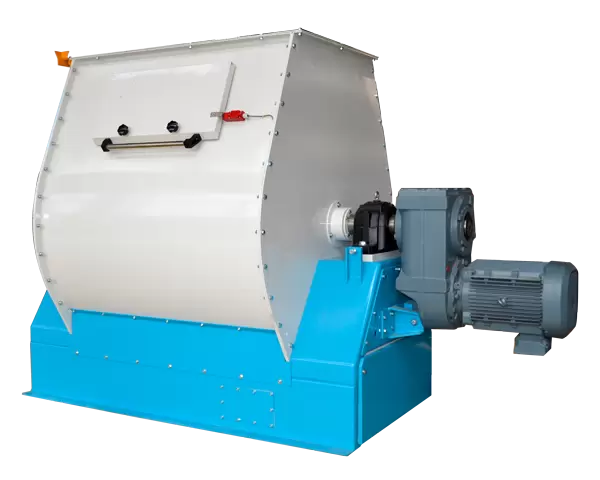- This topic is empty.
-
AuthorPosts
-
2025-02-10 at 2:13 pm #61867
Feed mixer is a common agricultural equipment, widely used for feed processing, mixing and uniform distribution. Its performance is directly related to the efficiency of feeding production, but in actual use, the equipment may fail to start, which will not only affect normal production, but also cause economic losses. The following is a detailed analysis of the causes, solutions and preventive measures when the feed mixer cannot start, to help users quickly troubleshoot and ensure the long-term stable operation of the equipment.
1. Common reasons why the feed mixer cannot start
Power supply problem
The feed mixer is mainly driven by electricity, and power problems are one of the most common reasons:
The power is not connected: the cable may be loose or the plug is not plugged in tightly.
Abnormal voltage: low or unstable voltage will cause the equipment to fail to start normally.
Circuit breaker tripping: overload or short circuit may cause the circuit breaker to trip and cut off the power supply.
Motor failure
The motor is the core component of the feed mixer, and its failure will directly affect the startup of the equipment:
Motor overheat protection startup: continuous working time may trigger the protection mechanism.
The internal winding of the motor is burned: the winding is damaged due to overload or long-term operation.
Motor bearing jamming: bearing wear or lack of lubrication causes jamming.
Control system problems
The start of the feed mixer depends on the electronic control system. Control failures may include:
The start button or switch is damaged: the circuit cannot be closed normally.
Relay or contactor failure: the current cannot be transmitted to the motor.
Aging or broken lines: the circuit cannot work properly.
Mechanical part blocking
Mechanical structure blocking is also a common cause:
Feed residue blockage: there is a lot of residue in the mixing chamber or feed inlet, causing the equipment to be overloaded.
Transmission system problems: loose or damaged chains, belts or gears.
Bearing or rotor stuck: parts are worn or foreign objects are stuck.
Environmental factors
The external environment may also cause the equipment to fail to start:
Cold weather: lubricating oil thickens in low temperature environments, increasing mechanical resistance.
Dust accumulation: too much dust on the motor or control panel affects normal operation.
Humid environment: electrical components may be damp and cause short circuits.

2. Specific solutions
Check the power supply
Make sure the power is on and check the connection of the plug, socket and cable.
Use a multimeter to measure whether the voltage is within the required range of the equipment (usually 220V or 380V).
Check whether the distribution box has tripped. If it has tripped, check the cause of overload or short circuit and then reclose it.
Check the motor
If the motor overheat protection is activated, wait for the motor to cool down before restarting, and check whether it is overloaded.
Check whether the motor winding is burned. If there is a burning smell or signs of winding breakage, the winding or motor needs to be replaced.
Lubricate the bearings. If the bearings are damaged, they need to be replaced in time.
Check the control system
Check whether the start button fails. If it is damaged, replace it with a new button.
Test whether the relay or contactor is working properly, and replace the faulty parts if necessary.
Use a multimeter to detect the circuit and repair the aging or broken parts.
Clean the mechanical part
Open the mixing chamber to check whether there is any residual material blocking, and clean it if necessary.
Check the transmission system, adjust the tightness or replace the worn chain and belt.
Check the rotor and bearings, remove stuck foreign objects and lubricate.
Optimize environmental conditions
Before starting the equipment under low temperature conditions, preheat the equipment or use low-temperature lubricating oil.
Clean the surface of the equipment regularly to prevent dust from affecting the heat dissipation of the motor.
Moisture-proof electrical components to ensure that the equipment operates in a dry environment.
3. How to prevent the feed mixer from failing to start
Regular maintenance
Check the motor, transmission system and control system regularly, and replace worn parts in time.
Add or replace lubricating oil regularly according to the requirements of the equipment manual.
Correct operation
Use the equipment strictly in accordance with the operating procedures to avoid overload operation.
Make sure there is no residue in the mixing chamber before stopping to reduce the risk of blockage.
Optimize the use environment
Place the equipment in a dry and ventilated place to avoid the impact of moisture on the electrical system.
In a dusty environment, increase protective measures and clean the equipment regularly.
Train operators
Provide professional training for operators to improve the level of equipment operation and daily maintenance.
Emphasis on troubleshooting methods to avoid greater losses due to misoperation.
Use high-quality spare parts
Choose parts with reliable quality to reduce the failure rate of equipment.
AuthorPostsViewing 1 post (of 1 total)- You must be logged in to reply to this topic.